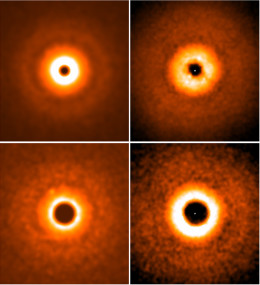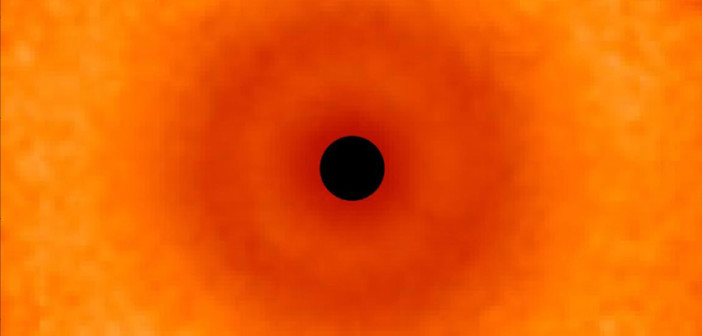Located a mere 176 light-years away, TW Hydrae is an 8-million-year-old star surrounded by a nearly face-on disk of gas and dust. Recent observations have confirmed the existence of a gap within that disk — a particularly intriguing find, since gaps can sometimes signal the presence of a planet.
Gaps and Planets
Numerical simulations have shown that newly-formed planets orbiting within dusty disks can clear the gas and dust out of their paths. This process results in pressure gradients that can be seen in the density structure of the disk, in the form of visible gaps, rings, or spirals.
For this reason, finding a gap in a protoplanetary disk can be an exciting discovery. Previous observations of the disk around TW Hydrae had indicated that there might be a gap present, but they were limited in their resolution; despite TW Hydrae’s relative nearness, attempting to observe the dim light scattered off dust particles in a disk surrounding a distant, bright star is difficult!
But a team led by Valerie Rapson (Rochester Institute of Technology, Dudley Observatory) recently set out to follow up on this discovery using a powerful tool: the Gemini Planet Imager (GPI).
New Observations

Comparison of the actual image of TW Hydrae’s disk from GPI (right) to a simulated scattered-light image from a model of a ~0.2 Jupiter-mass planet orbiting in the disk at ~21 AU (left) in two different bands (top: J, bottom: K1).[Adapted from Rapson et al. 2015]
These observations from GPI allowed Rapson and collaborators to unambiguously confirm the presence of a gap in TW Hydrae’s disk. The gap lies at a distance of ~23 AU from the central star (roughly the same distance as Uranus to the Sun), and it’s ~5 AU wide.
Modeled Possibilities
There are a number of other potential explanations for this gap — for instance, the inner disk could be casting a shadow on the outer disk, or the gap could be a natural consequence of how grains fragment and evolve within the disk.
Nevertheless, an orbiting planet embedded in the disk may well be the cause. When Rapson and collaborators ran numerical simulations of a planet orbiting within a disk like TW Hydrae’s, they found that a planet of 0.16 Jupiter masses, orbiting at a distance of 21 AU, reproduces the observations well.
With any luck, we’ll be able to learn more with additional observations in the future. Deeper images may reveal additional features that point to a planet shaping the disk structure. And if the planet is actively accreting gas in the disk, we may even be able to directly image the planet!
Citation
Valerie A. Rapson et al 2015 ApJ 815 L26. doi:10.1088/2041-8205/815/2/L26
